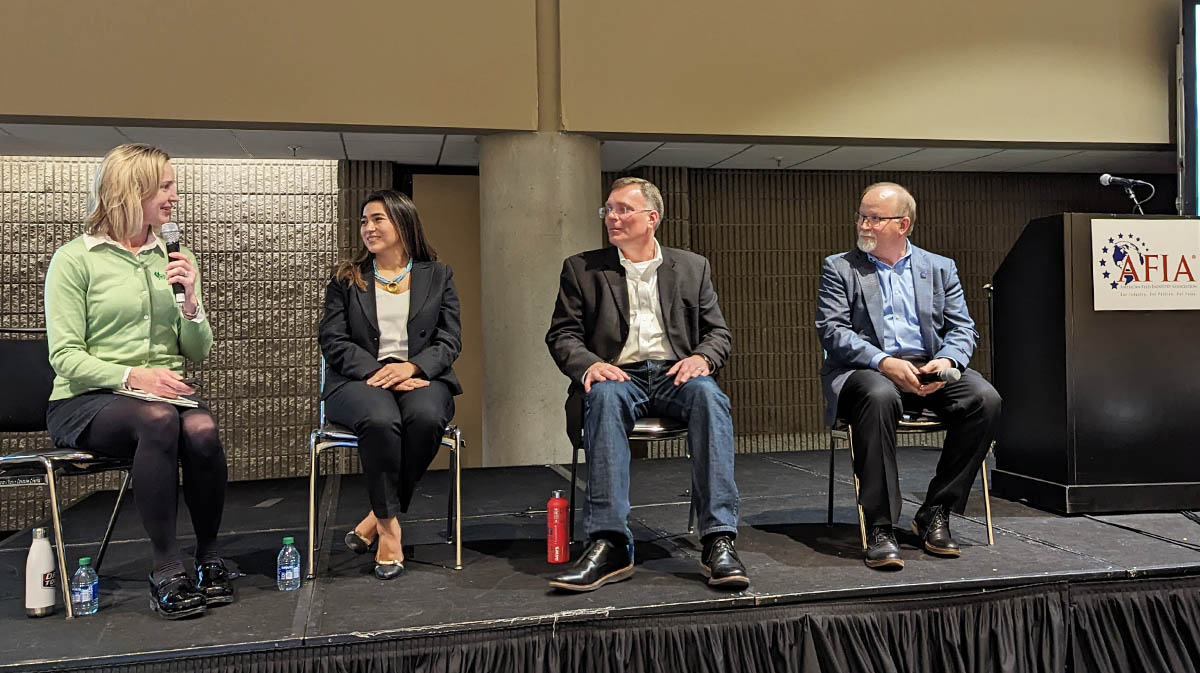This is the last of three articles covering a sustainability panel from the 2023 Pet Food Conference. Get the full story — read the first article here, and the second article here.
ATLANTA — There is no silver bullet when it comes to sustainability. While companies across the industry chart their own paths toward reducing their environmental footprints, it will require a group effort to reduce emissions across the value chain, also known as Scope 3 emissions.
This spirit of collaborative problem solving was demonstrated in a panel presented during the American Feed Industry Association’s (AFIA) 2023 Pet Food Conference, held Jan. 24 in conjunction with International Production & Processing Expo (IPPE) in Atlanta.
The panel, moderated by Lara Moody, executive director of the Institute for Feed Education and Research (IFEEDER), featured industry professionals from three corners of the industry — one consultant, one manufacturer and one supplier — who discussed their various strategies and insights for mitigating Scope 3 emissions. Panelists included Temis Coral, senior sustainability consultant at John Beath Environmental, LLC, Nicholas Rozzi, Ph.D., worldwide director of development at Hill’s Pet Nutrition, and Terry Ward, Ph.D., global director of strategy and sustainability at Zinpro Corporation.
 From left: Lara Moody, Temis Coral, Nicholas Rozzi, Ph.D., and Terry Ward, Ph.D. (Source: ©Jordan Tyler – Sosland Publishing Co.)
From left: Lara Moody, Temis Coral, Nicholas Rozzi, Ph.D., and Terry Ward, Ph.D. (Source: ©Jordan Tyler – Sosland Publishing Co.) In our first story about this panel, we covered classifications for Scope 3 emissions, how IFEEDER is supporting the industry in this effort, and what factors are driving this increased focus on sustainability. In our second story, we shared panelists’ insights on how manufacturers and suppliers can define the business case for Scope 3 sustainability in order to garner internal and value-chain engagement in their efforts, as well as the importance of collecting the right data.
In this third and final story, panelists discuss how compromising one piece of the puzzle could benefit — or harm — the bigger picture.
“We cannot solve everything at the same time,” Coral shared.
Tricky tradeoffs
One member of the audience posed an interesting question to the panel that speaks directly to the complexity of the issue at hand. Often when formulating for sustainability, certain tradeoffs must be made to reap the biggest — or most relevant — benefits for that particular company. For example, an LCA was conducted to look at environmental impacts of two ingredients. The results of the LCA showed a significant reduction in ocean biodiversity loss with one ingredient, but the carbon footprint was not significantly different between the two. How can a company choose the most valuable benefit to their company and the environment?
“If you take a soy product out of Brazil, unfortunately it has twice the carbon footprint of a product out of the United States, for example, because of that land use change that it impacts,” Ward said. “Diversity is right in there with it. At some point, we have to have a business case for the value proposition. At the same time, we have to be able to say, ‘It’s the right thing to do.’”
Similarly, plant-based proteins pose another “big picture” question for sustainability.
“[Whole grain] is a terrific source of protein and it’s very sustainable,” Rozzi said. “It’s a great way to go but, admittedly, as you start developing your concentrates and your isolates coming out of those grains, you’re adding to the carbon footprint.”
He explained that chicken meal, a rendered protein, has a very low carbon footprint compared to chicken and conventional protein isolates, extracts and concentrates. Ideally, he prefers to marry plant-based and animal-based proteins within the same formulation to reap the best possible benefit for emissions.
Approximately 25% of animal-derived calories go into pet food, Ward noted. To this point, he suggested formulating with ingredients that are more bioavailable and can not only reduce emissions, but also improve animal health and wellbeing.
“…For bioavailability of amino acids and minerals, we need to look at those and at concentrated products that don’t have carriers — or very limited carriers — so we can reduce, again, that transportation footprint through the whole chain,” Ward said. “When we provide product that has more available assets, especially essential amino acids like lysine, methionine, along with a trace mineral, then we improve the entire formulation. So, there are some formulation improvements where we can make efficiency improvements for the animal, not only for emissions, but from an animal health and wellbeing standpoint as well.”
When considering waste management, Coral noted that all cases are relative – there’s no silver bullet solution. Environmental impact, including negative impacts and positive reductions to emissions, all depend on what a company does with their waste, and each business has its own methods.
“If you’re [sending] that waste from the other side of the world to the United States to treat it, and then send it back, the transportation impact is going to be huge and will overcome the benefits of treating the waste instead of leaving it in one place,” she explained. “That is why we have the LCA, so you can evaluate the different impacts across each stage of the problem.”
Talk of circularity is gaining momentum, but there are still kinks to iron out. The circular economy refers to designing excess energy and waste out of the equation, but taking measure of these efforts can get hairy, Moody shared.
“LCAs get us a bit toward measuring for circularity, but there are other elements of circularity that LCAs don’t measure,” she said. “How important is that recycling within the system, and what’s the value on it behind just removing waste from the system?
“There is a lot of discussion, collaboration, consideration of circular economy right now,” she added. “In fact, the International Food Federation just initiated the Circularity Task Force to look at that topic. The real piece there is, we value circularity, we value coproduct and byproduct use within our animal food system, but what are the right metrics to be able to communicate on the value of that circularity?”
Because waste falls under Scope 3 emissions, this will certainly be a topic to watch in coming years.
“We have limited waste – that doesn’t mean there’s not room for improvement,” Ward said.
This is the last of three articles covering a sustainability panel from the 2023 Pet Food Conference. Get the full story — read the first article here, and the second article here.
Read more about the 2023 Pet Food Conference and other trending topics in the pet food industry.




